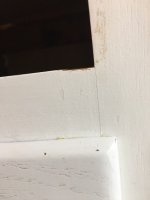So this is basically a continuation of my veneering threat, as I try to slowly leech out all the cabinet building information on this forum (bit by bit).
I'm building a cabinet to go under my MFT to drop the table height about 6 inches and put some storage under it (drawers). I'm planning to use a wooden drawer runner on the inside of the case and a dado on the drawer side. I've read that solid hardwood on solid hardwood is best for wooden runners.....buuuut, I've got baltic birch ply and that's what I want to use. I'm not sure how much this will affect the operation of the drawer.
I will be using a solid wood runner on the inside of the case, set in a dado. I want to use up some scrap for this and I've got choices. White oak, elm, walnut. Any opinions on what would be long lasting and make for smooth operation? I've also kind of going back and forth on the idea of putting a small strip of solid wood on the top side of the dado on the drawer itself, where it seems like most of the wear would be.
As far as hardwood on hardwood, does this have to do with the nature of hardwood vs softwood (like pitch)? Or is this because the softwood that's generally available is fast grown and course grained? I also have some scrap of old old pine and cypress (20+ growth rings per inch) that is very dense and heavy. The pine is heavier than some similar sized pieces of oak.
How do y'all do wooden drawer runners?
I'm building a cabinet to go under my MFT to drop the table height about 6 inches and put some storage under it (drawers). I'm planning to use a wooden drawer runner on the inside of the case and a dado on the drawer side. I've read that solid hardwood on solid hardwood is best for wooden runners.....buuuut, I've got baltic birch ply and that's what I want to use. I'm not sure how much this will affect the operation of the drawer.
I will be using a solid wood runner on the inside of the case, set in a dado. I want to use up some scrap for this and I've got choices. White oak, elm, walnut. Any opinions on what would be long lasting and make for smooth operation? I've also kind of going back and forth on the idea of putting a small strip of solid wood on the top side of the dado on the drawer itself, where it seems like most of the wear would be.
As far as hardwood on hardwood, does this have to do with the nature of hardwood vs softwood (like pitch)? Or is this because the softwood that's generally available is fast grown and course grained? I also have some scrap of old old pine and cypress (20+ growth rings per inch) that is very dense and heavy. The pine is heavier than some similar sized pieces of oak.
How do y'all do wooden drawer runners?

